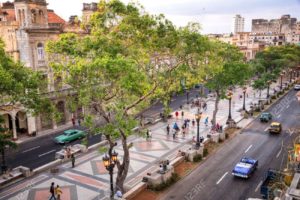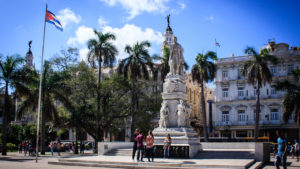 EL HABANERO PASEO DEL PRADO, CULTURA, COSTUMBRE Y TRADICION CUBANA.
EL HABANERO PASEO DEL PRADO, CULTURA, COSTUMBRE Y TRADICION CUBANA.
Desde su construcción por Felipe de Fons de Viela, marqués de la Torre, nombrado capitán general de la Isla, considerado como el primer gran urbanista de la ciudad se construyó el Paseo la Alameda de Paula en 1772 y dio inicio a las obras del Paseo del Prado, mejorado y embellecido luego por los gobernadores que lo sucedieron en el Gobierno.
Ha tenido varios nombres: Paseo del Prado, Alameda de Extramuros, Alameda de Isabel II, Paseo del Nuevo Prado, Paseo del Conde de Casa Moré y Paseo de Martí, que es su nombre oficial, aunque todos los cubanos se refieren a el solo como El Prado.
Este se extiende desde la actual Plaza de la Fraternidad hasta el Malecón, aunque el Parque Central lo divide en dos secciones bien diferenciadas.
Hacia 1841 ese paseo se convirtió en el centro de La Habana y la Plaza de Armas, oportunamente, desplazó a la Alameda de Paula como lugar de preferencia. Y el Prado a su vez desplazó a la Plaza de Armas, por su mayor extensión y amplitud, más adecuadas a la importancia y población que iba adquiriendo la ciudad.
A finales del siglo XVIII coches de diversas características -fiel reflejo de sus propietarios- dominaban el entorno del popular paseo y la costumbre de recorrerlo convirtió a la citada alameda en un pequeño escenario de la sociedad habanera de la época
En el período 1928-1929 se decidió su imagen definitiva, hasta el presente, se construyeron bancos de piedra con respaldo y base de mármol, se colocaron elementos ornamentales como copas y ménsulas en profusión a lo largo del paseo, se colocaron las farolas artísticas de hierro y los ocho leones de bronce que lo custodian desde sus pedestales.
El paseo central se pavimentó con un bello piso de terrazo. Al construirse el Capitolio el 20 de mayo de 1929, lugar que marca el kilómetro cero de la red de carreteras de Cuba, se eliminó una sección del Paseo y se remodeló la que se mantuvo, integrándose las áreas exteriores del mismo al Paseo del Prado, a la Plazoleta de la Fuente de la India, y al Parque de la Fraternidad.
A fines del siglo XIX y comienzos del XX, aristócratas, burgueses y profesionales se fueron a vivir al Prado; en tanto abrían sus puertas los mejores hoteles de la ciudad (El Plaza, El Sevilla y El Inglaterra) sobre el Paseo del Prado, sitio de encuentro para la corriente turística foránea.
Hacia fines del siglo XIX, el Paseo del Prado pasó a ser un espacio para el recorrido de peatones en lo fundamental, complementado con el nuevo Parque Central que surgió en sus inmediaciones.
Así en la vial del Paseo del Prado se ubicaron construcciones civiles de marcado uso social: sociedades de recreo, hoteles, cines, teatros, y al mismo tiempo importantes mansiones, construcciones todas de marcada filiación al eclecticismo, con las más variadas formas en el diseño.
Céntrico, histórico y célebre está rodeado escoltado de verdaderas joyas arquitectónicas, palacios residenciales de inicios del siglo XX e importantes instalaciones culturales, sociales y comerciales que dan vida y brillantez al mismo. Farolas artísticas de hierro y ocho leones de bronce custodian desde sus pedestales el Paseo del Prado, en La Habana
En la actualidad, cumplidas los 5 siglos de fundación de La Habana, la importante arteria combina armónicamente su estructura colonial junto a la modernidad que como valor agregado le otorgan varios majestuosos hoteles, entre los que destacan -los remozados ‘Packard’ y ‘Paseo del Prado’– que se alzan frente al Malecón desafiantes del tiempo y los embates del mar y los vientos.
 HABANERO ‘PASEO DEL PRADO’, CULTURE, CUSTOMS AND CUBAN TRADITION.
HABANERO ‘PASEO DEL PRADO’, CULTURE, CUSTOMS AND CUBAN TRADITION.
Since its construction by Felipe de Fons de Viela, Marquis de la Torre, named captain-general of the Island, considered the first great urban planner of the city, the Paseo la Alameda de Paula was built in 1772 and began the works of the Paseo del Paseo Prado, improved and later embellished by the governors who succeeded him in the Government.
He has had several names: Paseo del Prado, Alameda de Extramuros, Alameda de Isabel II, Paseo del Nuevo Prado, Paseo del Conde de Casa Moré and Paseo de Martí, which is his official name, although all Cubans refer to him only as The meadow.
This extends from the current Plaza de la Fraternidad to the Malecon, although Central Park divides it into two distinct sections.
Towards 1841 that walk became the center of Havana and the Plaza de Armas, opportunely, displaced the Alameda de Paula as a place of preference. And the Prado, in turn, displaced the Plaza de Armas, due to its greater extent and breadth, more appropriate to the importance and population that the city was acquiring.
At the end of the 18th-century cars of various characteristics – a true reflection of their owners – dominated the environment of the popular promenade and the custom of traveling it turned the mentioned mall into a small stage of the Havana society of the time
In the period 1928-1929 its definitive image was decided, until now, stone benches with a back and marble base were built, ornamental elements such as cups and corbels were placed in profusion along the promenade, the artistic lampposts of iron and the eight bronze lions that guard it from their pedestals.
The central promenade was paved with a beautiful terrazzo floor. When the Capitol was built on May 20, 1929, place that marks kilometer zero of the road network of Cuba, a section of the Paseo was removed and the one that was maintained was remodeled, integrating the exterior areas of the same to the Paseo del Prado, to the Plazoleta de la Fuente de la India, and to the Fraternity Park.
In the late nineteenth and early twentieth centuries, aristocrats, bourgeois and professionals went to live in the Prado; while the best hotels in the city (El Plaza, El Sevilla, and El Inglaterra) opened on the Paseo del Prado, a meeting place for the foreign tourist current.
Towards the end of the 19th century, the Paseo del Prado became a space for the pedestrian route in the main, complemented by the new Central Park that emerged in its vicinity.
Thus, on the Paseo del Prado road, civil constructions of marked social use were located: recreational societies, hotels, cinemas, theaters, and at the same time important mansions, all buildings of marked affiliation to eclecticism, with the most varied forms in the design.
Central, historical and famous, it is surrounded by real architectural jewels, residential palaces of the early twentieth century and important cultural, social and commercial facilities that give life and brilliance to it. Artistic iron lampposts and eight bronze lions guard the Paseo del Prado from Havana on their pedestals in Havana
At present, after the 5 centuries of foundation of Havana, the important artery harmoniously combines its colonial structure with the modernity that as a value-added several majestic hotels give it, among which stand out – the refurbished ‘Packard’ and ‘Paseo del Prado ‘- that rise in front of the boardwalk challenging the weather and the onslaught of the sea and winds.
Agencies/ RHC/ Guadalupe Yaujar/ Extractos/ Excerpts/ Internet Photos/ Arnoldo Varona/ www.TheCubanHistory.com
THE CUBAN HISTORY, HOLLYWOOD.











